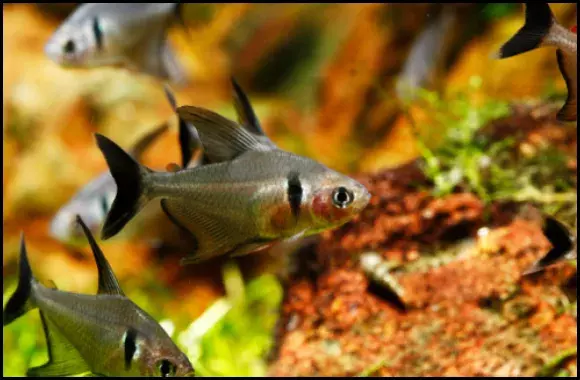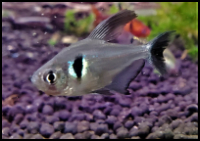


Quick Care Details (Table)
| Livestock Characteristics | Value |
|---|---|
| Care Level | Moderate |
| Temperament | Semi-Aggressive |
| Diet | Omnivore |
| Maximum Size | 2 Inches |
| Minimum Tank Size | 10 Gallons |
| Plant Safe | Yes |
| Temperature Range | 72-82F |
| PH Range | 6.0-7.5 |
| KH Range | 8-18 |
Species Specific Categories
Helpful Video
Care Details
Aquascape:
- Black Phantom Tetras thrive in heavily planted aquariums with plenty of hiding spots.
- Utilize driftwood, rocks, and decorations to create caves and crevices for them to explore.
Substrate:
- Choose a fine-grained substrate like sand or smooth gravel to mimic their natural habitat.
- Ensure the substrate is well-rinsed to prevent cloudiness in the water.
Disease Prevention:
- Maintain excellent water quality through regular water changes and proper filtration.
- Quarantine new fish before introducing them to the main aquarium to prevent the spread of diseases.
Filtration:
- Use a reliable aquarium filter rated for the size of your tank to maintain water clarity and quality.
- Consider adding additional filtration or a powerhead to ensure adequate water flow.
Lighting:
- Provide moderate lighting to support plant growth without causing excessive algae growth.
- LED lights with adjustable intensity and spectrum are ideal for controlling lighting levels.
Water Flow:
- Black Phantom Tetras prefer gentle to moderate water flow.
- Position the filter outlet and powerhead to create gentle currents throughout the tank.
Hardiness:
- Black Phantom Tetras are relatively hardy and can adapt to a range of water conditions.
- Maintain stable water parameters to prevent stress-related issues.
Acclimation:
- Slowly acclimate new fish to the aquarium environment by gradually adjusting the water parameters over a period of time.
- Use a drip acclimation method to minimize stress during the transition.
Expected Lifespan:
- Black Phantom Tetras typically live for 3-5 years with proper care.
- Providing a suitable environment and diet can help maximize their lifespan.
Special Requirements:
- Ensure the tank is well-aerated as Black Phantom Tetras prefer well-oxygenated water.
- They appreciate a varied diet consisting of high-quality flakes, pellets, live, and frozen foods.
Temperament and Behavior
Behavior:
- Black Phantom Tetras are peaceful and social fish that prefer to swim in groups.
- They are active swimmers, especially when kept in a school.
Breeding:
- Black Phantom Tetras are egg scatterers, and breeding can occur in a well-maintained aquarium with appropriate conditions.
- Provide fine-leaved plants or spawning mops for them to deposit their eggs.
Aggression:
- These tetras are generally peaceful and not aggressive towards other fish species.
- However, during breeding periods, they may display minor aggression towards each other.
Tankmates Compatibility:
- Black Phantom Tetras are compatible with other peaceful fish species that share similar water parameters.
- Avoid keeping them with larger or aggressive tankmates that may intimidate or harass them.
Activity Level:
- They have a moderate activity level and are most active during feeding times and when exploring their environment.
Schooling or Shoaling Behavior:
- Black Phantom Tetras exhibit schooling behavior and should be kept in groups of at least six individuals.
- Being in a school helps reduce stress and encourages natural behavior.
Plant Compatibility:
- These tetras are generally compatible with live plants, but they may nibble on softer leaves.
- Choose sturdy plant species like Java fern or Anubias to withstand their nibbling behavior.
Diet and Nutrition
- Dry Foods:
- Black Phantom Tetras readily accept high-quality dry foods such as flakes and pellets.
- Look for formulations specifically designed for tetras to ensure they receive essential nutrients.
- Frozen Foods:
- Offer a variety of frozen foods like bloodworms, brine shrimp, and daphnia as occasional treats.
- Frozen foods provide variety and essential nutrients, enhancing their overall diet.
- Live Foods:
- Black Phantom Tetras enjoy live foods such as live brine shrimp, mosquito larvae, and blackworms.
- Live foods can stimulate their natural hunting instincts and provide additional nutrition.
- Vegetables:
- While primarily carnivorous, Black Phantom Tetras may nibble on blanched vegetables like zucchini or spinach.
- Vegetables can provide fiber and essential nutrients as supplementary treats.
- Algae:
- Black Phantom Tetras may nibble on soft algae growth in the aquarium but should not rely solely on algae for their diet.
- Provide a balanced diet supplemented with algae-based foods for optimal nutrition.
- Feeding Schedule:
- Feed small amounts multiple times a day to mimic their natural feeding behavior and prevent overeating.
- Adjust feeding frequency based on their activity level and appetite.
- Supplemental Foods:
- Supplement their diet with high-quality, protein-rich foods like bloodworms, brine shrimp, and daphnia.
- Offer a variety of foods to ensure they receive a balanced diet and essential nutrients.
Tank Parameters
- Tank Size:
- Black Phantom Tetras are small fish and can be kept in tanks as small as 10 gallons.
- However, larger tanks provide more swimming space and stability in water parameters.
- Tank Length and Measurements:
- Aim for a tank with dimensions that provide ample swimming space for the tetras.
- A tank length of at least 20 inches is recommended to accommodate their active swimming behavior.
- Water Temperature:
- Maintain a water temperature between 72-78°F (22-26°C) for Black Phantom Tetras.
- Use a reliable aquarium heater and thermometer to regulate and monitor water temperature consistently.
- pH (Acidity/Alkalinity):
- Keep the pH level between 6.5-7.5 for optimal health and well-being of the tetras.
- Stability in pH is crucial to prevent stress-related issues and promote natural behaviors.
- KH (Carbonate Hardness):
- Aim for a KH level between 3-8 dKH to maintain stable pH levels and buffer against sudden fluctuations.
- Test KH regularly, especially if using tap water, to ensure appropriate levels for Black Phantom Tetras.
- GH (General Hardness):
- Maintain a GH level between 5-12 dGH to provide essential minerals for overall health and vitality.
- Consistent GH levels support proper osmoregulation and promote healthy growth.
- Hardiness:
- Black Phantom Tetras are relatively hardy and can adapt to a range of water conditions.
- Maintain water quality, temperature, and parameters within the recommended ranges to ensure their well-being.
- Nitrate (NO3) Levels:
- Keep nitrate levels below 20 ppm (parts per million) through regular water changes and proper filtration.
- Elevated nitrate levels can lead to health issues for Black Phantom Tetras, so monitor and maintain levels within the recommended range.
History, Popularity, History and Species Variety Details
The History, Popularity and Natural Habitat
The History: The Black Phantom Tetra (Hyphessobrycon megalopterus) has a rich history in the aquarium hobby. This species was first introduced to the aquarium trade in the early 20th century. It hails from South America, particularly from the Paraguay and Paraná River basins in Brazil. Initially, it was primarily found in wild-caught specimens, but due to its popularity among aquarists, it has been successfully bred in captivity for many years. Over time, it has become a staple in freshwater community tanks, valued for its striking appearance and peaceful temperament.
Popularity: The Black Phantom Tetra is widely regarded as one of the most popular tetra species in the aquarium hobby. Its popularity stems from several factors, including its stunning appearance, ease of care, and peaceful nature. The striking contrast of its black body with red fins and a distinctive "phantom" mark near its dorsal fin makes it a standout in any aquarium. Additionally, its peaceful temperament makes it an excellent choice for community tanks, where it can coexist harmoniously with a variety of tank mates. Due to its popularity, it is readily available in most pet stores and online retailers, making it accessible to aquarists of all experience levels.
Natural Habitat: In its natural habitat, the Black Phantom Tetra inhabits slow-moving rivers, streams, and tributaries in South America. Specifically, it is found in the Paraguay and Paraná River basins in Brazil. These water bodies are typically shaded by dense vegetation, and the tetras can be found in areas with submerged vegetation, fallen branches, and leaf litter. The water in these habitats tends to be soft and slightly acidic, with temperatures ranging from 72-78°F (22-26°C). Black Phantom Tetras are shoaling fish and are often found in groups, navigating the dimly lit waters in search of food and shelter.
Similar and Variations of the Species:
- Red Phantom Tetra (Hyphessobrycon sweglesi)
- Bleeding Heart Tetra (Hyphessobrycon erythrostigma)
- Black Neon Tetra (Hyphessobrycon herbertaxelrodi)
- Diamond Tetra (Moenkhausia pittieri)
- Serpae Tetra (Hyphessobrycon eques)
- Rosy Tetra (Hyphessobrycon bentosi)
Personal Perspective
Black Phantom Tetras has been nothing short of captivating. I still remember the day I introduced these stunning fish into my tank, their sleek black bodies adorned with vibrant red fins immediately adding an elegant touch to the aquatic landscape. Watching them gracefully glide through the water, their movements synchronized as they explored every nook and cranny of their environment, filled me with a sense of wonder and tranquility. One of my most cherished memories is witnessing their playful interactions during feeding time, as they eagerly darted around to catch their favorite treats. Over time, these tetras have become more than just inhabitants of my aquarium; they have become beloved companions, each with their own unique personality quirks that never fail to bring a smile to my face. Through moments of joy and challenges alike, my journey with Black Phantom Tetras has been a rewarding experience filled with endless fascination and wonder.
Frequently Asked Questions
Can Black Phantom Tetras live with shrimp or snails?
In general, Black Phantom Tetras are peaceful and should not bother shrimp or snails. However, individual personalities may vary, so keep an eye on them to ensure compatibility.
Do Black Phantom Tetras have any specific breeding requirements?
Black Phantom Tetras can breed in captivity with appropriate conditions, including soft, slightly acidic water and plenty of hiding spots for spawning. However, they may not breed as readily as some other tetra species.
Can Black Phantom Tetras eat live plants?
While Black Phantom Tetras typically don't eat live plants, they may nip at softer leaves. Choose sturdy plant species like Java fern or Anubias to withstand their nibbling behavior.
How many Black Phantom Tetras should I keep together?
Black Phantom Tetras are shoaling fish and thrive in groups. It's recommended to keep them in schools of at least six individuals to promote their natural behavior and reduce stress.
Can Black Phantom Tetras live with other tetra species?
Yes, Black Phantom Tetras are generally peaceful and can coexist with other tetra species in a well-maintained community aquarium. Just ensure there's enough space and hiding spots for all fish to thrive.

